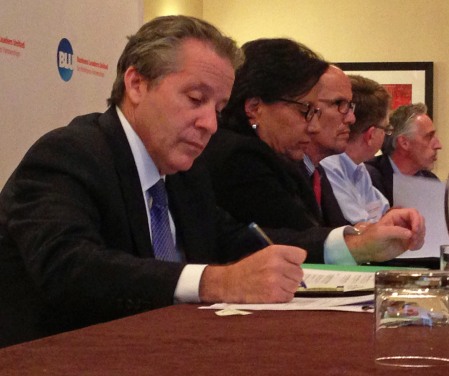I had the privilege of participating in the Business Leaders United Fly-In to Capital Hill in Washington D.C. earlier this week representing the Precision Machined Products Association.
In our Monday evening meeting we were joined by Secretary of Labor Tom Perez, Secretary of Commerce Penny Pritzger, and from the White House, Gene Sperling, Director of the National Economic Council and Assistant to the President for Economic Policy.

Two Cabinet Secretaries and the Top White House Economic Advisor showed me that Washington realizes we have a skilled workforce problem.
The fact that we got to meet with top staffers at various Senate and House offices, as well as staffers from the Senate HELP (Health, Education, Labor, and Pensions) Committee convinced me that we had the attention of the folks who could make a difference in Washington, D.C..
I spoke with top staff assistants handling policy for Speaker Boehner and Senator Portman from my home state of Ohio.
We had substantive and frank discussions about the facts (on which we all seemed to agree) and possible solutions for this issue.
What worked – creating employer driven partnerships- even among competitors- summer youth programs, quantifying local area opportunities and job market research to make the career case- was shared and explored.
The challenges- lack of educational attainment, lack of ‘soft skills,’ and various funding issues were also discussed.

Despite the news stories about tension and gridlock in D.C, we were able to speak to the people that can help solve this problem.
It is no longer about admitting that we have a lack of skilled workers in the ‘unemployed workforce.’
There was no evidence of denial of the problem of unemployment and lack of skills.
What all of our contacts asked about was centered around three key questions:
- What works to help us qualify and put to work long term unemployed in middle skill jobs?
- How do we build the ROI case for this?
- How do we scale it nationwide?
My fellow small business delegates from BLU shared some of their challenges, but more importantly, their success stories of their local partnerships.
What Washington wants/needs to know is how can we build these up to gain national traction?
What would you suggest?






Thank you Miles for entering the discussion on the skills gap. I cannot believe both sides of the isle cannot come together to address the training needs to match the unemployed/under-employed with the skills needed in today’s high-tech manufacturing.
We too struggle to find qualified candidates and currently have 6 unfilled positions.
Some business owners I know have had the same challenge on finding the skill level required for certain positions. Some have bit the the bullet and took a chance on a couple of applicants that showed some promise. They payed alot less than the pay scales with the promise of elevating the pay as the employee progressed to achieving certain thresholds in the position. Call it an apprenticship program which businesses seemed to have forgotten in a high paced manufacturing enviroment where revenue seems to be the most immediate goal. When businesses have the resources during the lean times this can be a viable option and sometimes they create a employee that is tailored and “who grew up” in the enviroment of the business and creates loyality in return.
When I tell people that each CEO I speak with will add a skilled person even without having an open position, they just look at me like I am from Mars. Six open positions folks, in a highly regarded and well paying field making high tech components for tomorrow’s technology. Six positions. Open and unfilled.